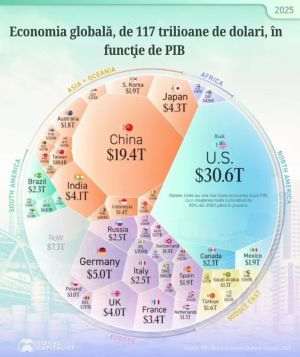• According to Eurostat, Romania has the biggest governmental deficit in the EU
The hike of some taxes, in the near future, is unavoidable, according to economic analyst Aurelian Dochia.
His statement comes as, in the first quarter, the government's deficit has seen an increase over the last quarter of 2017, according to data by the European Statistics Office (Eurostat).
The economic analyst told us the following, on Friday: "In order to overcome this situation, there are a few solutions. On one hand, we can try and attempt to control the budget expenses, but we can't work with any of these expenses, especially since 2019 is an electoral year, and the other solution is the raising of some taxes (that measure isn't popular in an electoral year, but I think that somewhere it will be done, regardless of whether it is towards the end of 2019, or in 2020, after the elections. It is hard to believe there is another solution".
Mr. Dochia believes that the budget deficit has increased compared to last year, first of all because the budget expenses have increased - salaries, pensions and welfare payments have increased - as well as investments, in the first part of this year, unlike 2017, when they reached an extremely low level.
"This makes this year's situation even more worrisome, than last year, because at the end of 2017 it was possible to adjust the final deficit by cutting investments. This time, it's impossible to do that, and there is a great risk, that everybody has discussed, both officially and unofficially, of exceeding the threshold of 3% of the GDP. Sure, investments are desirable, but you need to have sources in order to make them, and ours are inexistent. Furthermore, the fact that we have a deficit means that we borrow and that's where the money for salaries, pensions and investments comes from", the quoted source said, and pointed out that the even the European Commission expects Romania's budget deficit will exceed 3% of the GDP.
Starting with the third quarter of the year, the direction towards which our country is gravitating, where deficit is concerned, will become clear, but the government won't have the option of halting investments at the end of the year, to make adjustments and prevent overshooting, like they did last year, which is why 2019 doesn't look too encouraging either, Mr. Dochia, says. "The problem isn't just for 2018. What is happening now means that we are starting now with a rather large deficit from the previous year, and all the expenses that the budget makes are mandatory because, if we're talking salaries and pensions, you can't just come in «the next day» and say you are cutting them. Thus, next year will be even more difficult".
Whereas in the European Union and in the Eurozone the government deficit has fallen 0.1 percentage points in Q1 2018, compared to the last three months of 2017, in Romania the governmental deficit has seen the biggest increase among member states, with 1.9 percentage points, from a deficit of 2.3% of the GDP in Q4 2017, up to 4.2% of the GDP in the first three months of 2018, according to Eurostat, quoted by Agerpres.
In the Eurozone, the government deficit has amounted to 0.1% of the GDP in Q1 2018, down from 0.6% in the previous three months, whereas in the European Union the governmental deficit has amounted to 0.5% of the GDP, down from 0.6%.
Among EU member states, the highest government deficit in Q1 2018 compared to the last three months of last year was seen in Romania (4.2% of the GDP), France (2.5%) and Great Britain (1.9%), and the highest governmental surplus was seen in Malta and Holland (both with 2.5%) and Bulgaria (2.4%).
In Q1 2018, compared to the similar period of 2017, the Eurozone had a surplus of 0.5% of the GDP, from a deficit of 0.1% of the GDP in the last three months of 2017, whereas the European Union has had a surplus of 0.1% of the GDP, similar to the previous three months.
Among EU member states, the highest government deficit this quarter, compared to the similar period of 2017, was seen in Denmark (3.2% of the GDP), Luxemburg (2.9% of the GDP) and Romania (1.9% of the GDP), and the highst government surpluses were in Hungary (3.4%), Latvia (2.9%) and Bulgaria (2%).

























































